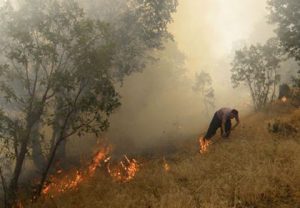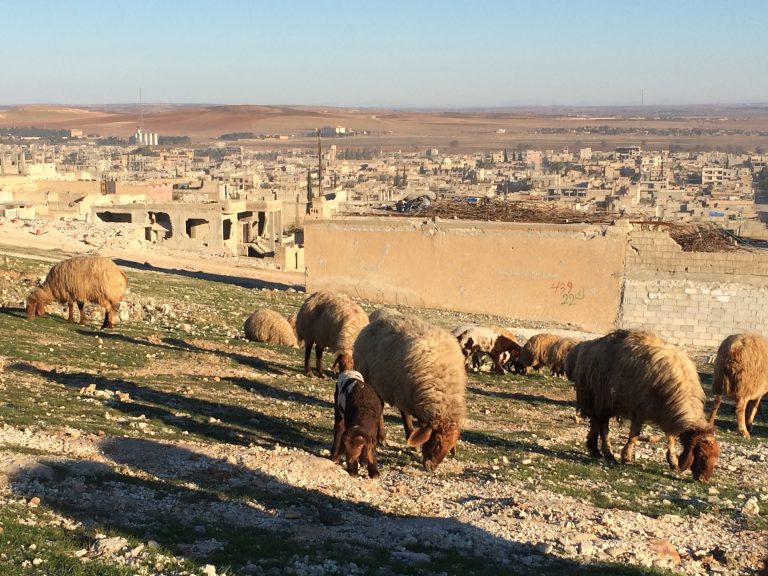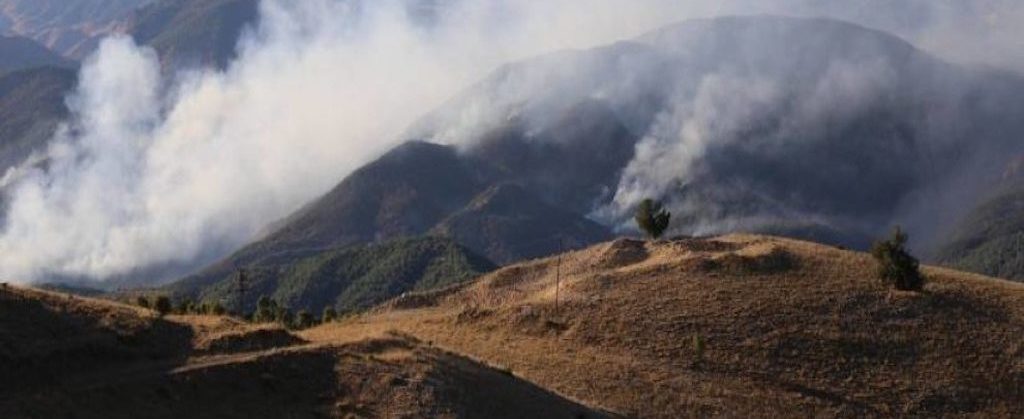“A society cannot be democratic towards ethno-religious minorities or be truly gender progressive if it cannot first and foremost demonstrate an integral and profound respect for our shared land.”
The ongoing war against ISIS in Rojava (Western Kurdistan) has brought the Kurds and their struggle for autonomy and freedom to international attention like never before. Much attention has been paid surrounding the concept of Democratic Confederalism, to the bravery of the YPJ in the fight against ISIS, to the democratic institutions being built, to the creation of the Syrian Democratic Forces, and to multiculturalism. But one area that has generated far less relative attention has been the ecological pillar of the democratic model being birthed in Rojava
Of Democratic Confederalism’s three pillars—radical democracy, gender liberation, and ecological sustainability—I would argue that the latter is the most crucial, and sets the foundation for a truly democratic, inclusive and egalitarian society. A society cannot be democratic towards ethno-religious minorities or be truly gender progressive if it cannot first and foremost demonstrate an integral and profound respect for our shared land.
“The land as a site of resistance, as a means of political and ideological self-preservation, as a clear symbol of the alternative to the fascism of the modern statist mentality and its annihilation and erasure of the rich cultural mosaic existing within its borders.”

The environmental consequences of the Kurds’ liberationist aspirations have been devastating. Just as the occupational regimes in questions used gender based violence as a form of controlling Kurdish political aspirations, the land has attracted similar violent policies. For this reason, reviving the environment, consciously discarding capitalist methods of agriculture and animal husbandry, and adopting an ecologically sustainable approach towards the land has multiple meanings for the Kurds. The land as a site of resistance, as a means of political and ideological self-preservation, as a clear symbol of the alternative to the fascism of the modern statist mentality and its annihilation and erasure of the rich cultural mosaic existing within its borders. For this reason, the mark of Rojava’s real adherence to democracy, in the end, will be proven in its respect to, and implementation of, ecological sustainability.
For the Kurds, like most indigenous dispossessed and stateless people, the connection with the land and ecological protection has an added identity, historical and ideological meaning. It is therefore natural that the importance of ecological sustainability has emerged in the Kurdish context within the current model of Democratic Confederalism in practice in Rojava.
Each year across Greater Kurdistan you have a combination occupational calamities: from Iranian artillery shelling, to Turkish airstrikes, to deliberate fires lit by the military forces of these regimes, to the killing of carrier animals of poor Kurdish villagers making a living through smuggling across the ‘borders’, to thousands of acres of orchards, thousands of livestock killed, olives and pistachio trees uprooted across Kobane under ISIS, to the ongoing damage of ancient olive trees in Afrin – the environment of Kurdistan has experienced the full range of fascist violence. Moreover, just as the Taliban destroyed ancient Bamiyan Buddhist temples in Afghanistan, and ISIS destroyed the Unesco World Heritage site of Palmyra, including the 2,000 year old Temple of Bel, an increasingly Islamo-fascist Turkish government has implemented the same model towards Kurdish land and monuments, including blowing up the 12,000 year old world heritage site of Hasankeyf in Northern Kurdistan (southeast ‘Turkey’) and the 3,000 year old temple in Ain Dara in Afrin. The same perverse mentality has also seen thousands of Kurdish graves bombed and dug up by Turkey.
“…the shielding mountains and sheltering valleys of Kurdistan have also been a target for assimilation, counter insurgency, and ethnic cleansing policies.”
Historically, the nature of the Kurdish liberation movements has been such that the environment, from the Zagros mountain ranges to Qandil, to Halgord and Shaho have served as a natural barrier against oppressive policies imposed by the regimes of the region. From the Peshmerga to the PKK, the mountains and terrain of Kurdistan has been used to wage guerrilla attacks and warfare against the occupying regimes. But for this very reason, the shielding mountains and sheltering valleys of Kurdistan have also been a target for assimilation, counter insurgency, and ethnic cleansing policies.
“Thousands of villages were razed, and hundreds of thousands of people, including non-Kurds like Assyrians, were displaced or murdered as a result.”
In the 1980’s-1990’s alone, in Turkey and Iraq over 10,000 Kurdish villages were destroyed, evacuated at gun point, and razed. In Turkey, between 1991-1995, over 5,000 villages were destroyed with the intention of fundamentally transforming Kurdish society and culture, and eliminating an important support base for the PKK guerrillas. Likewise in Iraq, Saddam’s regime implemented the same policy of ethnic cleansing during its notorious Al Anfal campaign, as well as widely during the 1980-1988 Iran-Iraq war in which the Kurds in Iraq fought against his regime. Thousands of villages were razed, and hundreds of thousands of people, including non-Kurds like Assyrians were displaced or murdered as a result.
“For as long as the mountains remain, Kurds know a safe haven can be accessed.”
These policies of environmental destruction and spatial control have been deliberate, systematic, and consistent across the four regions of Greater Kurdistan. The domination, controlling and methodical razing of the natural terrain in Kurdistan involves a patriarchal, capitalist, fascist mentality of assimilation and destruction of Kurdish culture, identity and history as well as those who share the land with them. It is an attempt at severing the essential umbilical cord between the Kurds and the land—seen as fundamentally linked to Kurdish ideas of freedom, democracy, and collective coexistence. Likewise, despite the increasing war and military capacity of the regimes in question, the mountains continue to protect the KCK-affiliated guerrillas (PKK, PYD, PJAK) and Peshmerga forces across the region. Despite advances in technology and warfare, capitalism has yet to defeat the terrain and mountains of the region and they remain an important site of resistance, both physically and metaphorically. For as long as the mountains remain, Kurds know a safe haven can be accessed.
For this reason, protecting the environment, investing in ecological and sustainable practices and adopting this mentality as integral to individual and collective freedom should be a concept fundamental to all Kurds. It is not only another form of resistance, another form of self-protection, security, but also another form of maintaining the continuity of the mosaic of Kurdish cultures. It is also a reminder that the fight against fascist forces, and the fight for the survival of the oppressed and the disposed can be held across multiple fronts. It can take the form of not only military self-protection, but the formation of grassroots democratic institutions and civil society organizations. Naturally, this protection cannot involve a patriarchal, chauvinistic possession of the land, but rather an organic, respectful, courageous, revolutionary sensitivity towards the shared land as a representation of not only self-love for the oppressed, but communal love and democratic co-existence.
Previously, Rojava suffered devastating ecological damage under the Assad regime, which makes their attempt at ecological revival all the more remarkable. Under Damascus rule, thousands of acres of ancient forests were cut down to make space for capitalist state ventures by implementing wheat production. As a consequence, to date close to 70% of all agricultural output for Syria comes out of the northern regions encompassing Rojava. Likewise, during the 1960’s to 1980’s a range of Baathist Arabization and assimilation policies, land confiscations and ethnic gerrymandering occurred. Water resources were redirected to Arab dominated areas, while lands, farms, livestock, and orchards were handed over to Arab families transported from other parts of Syria to take over Kurdish lands. Likewise, as part of the deliberate policies of the regime, sanitation, urban planning, and the necessary infrastructure were never established across the northern regions as a deliberate means of maintaining economic underdevelopment, and hence controlling Kurdish aspirations.
In light of this history, and the impact of the war on ISIS, plus Turkey’s ongoing airstrikes and shelling around the Afrin regions, it was essential that the land was revived not only as a living symbol of the alternative, but also as a means of ensuring food security in a region heavily embargoed by Turkey.
“Everything done in Kobane and Rojava had a significant ideological meaning behind it.”
As a result, dozens of agricultural co-operatives have emerged, many led by women or villages. In Kobane, under my NGO Hevi Foundation in 2017, we collected over $15,000 of donations which were handed over to the municipality, who then purchased locally grown saplings to plant around the city. The idea behind this project was that each tree would represent a martyr whose name would be placed as a placard by the tree. The family of the martyr would be responsible for the maintenance and growth of the tree, watering it and so on. Everything done in Kobane and Rojava had a significant ideological meaning behind it. The planting of the trees represented a connecting link between the community, those who had sacrificed the most and the notion of liberation; a liberation which lived physically and metaphorically through the newly planted saplings.
“Using water as a weapon, the deliberate limiting of water flow through the Euphrates River has been a policy adopted routinely by Erdogan’s regime.”
However, the ecological element has always taken a back foot in light of the ongoing war and invasions across Rojava. In mid 2015, as part of our work under the Kobane Reconstruction Board, tasked with rebuilding the destroyed city, we discussed the importance of solar panels to address the lack of electricity, but we were constrained due to a lack of funds, the closed borders, and needing to prioritize. By December 26th, 2015, Tishrin Dam had been liberated and we finally had the opportunity to return electricity to the city. Despite the immense damage to the electricity lines, less than a month later, Kobane had electricity. However, the hydro dams are heavily reliant on water up river, controlled by Turkey. Using water as a weapon, the deliberate limiting of water flow through the Euphrates River has been a policy adopted routinely by Erdogan’s regime.

The implementation of the ecological sustainability process has also not been easy or smooth. From the lack of sanitation causing massive damage to water systems, to mismanagement of trash, to a lack of a committed recycling mentality—let alone facilities—to hundreds of water wells being dug and its impact on the water basin, extensive ecological problems remain. Likewise hundreds of stray dogs and cats roamed the rubbish heaps and travel in packs within the cities causing further sanitation and hygiene issues. Initially many of these animals had to be put down as many had survived during the war on dead bodies. These problems persist not because Rojava lacks an ecologically sustainable consciousness, but rather because the region is heavily under war conditions, the war with ISIS continues, the economy has been severely damaged due to the embargo, and difficult decisions need to be made regarding resources, expertise, equipment, and funds on a daily basis. As such, international support, expertise, and donations are essential in helping Rojava carry this burden.
Thousands of acres of forest and orchards were destroyed. The olive trees, which were sacred and represented the people’s connection to the land, were cut down in their thousands.

I remember the first time I saw livestock in Kobane in late 2015. The sheep roamed on Mishtanur hill, the sound of their bells tinkling melodically in the crisp early morning as the sun rose over the liberated city. Part of my job in the Kobane Reconstruction Board was to document the reconstruction process; to me this moment was just as important as rebuilding the schools and roads. I took photos. I felt emotional, even as I wanted to laugh at myself for taking photos of such an ordinary scene as a herd of sheep. It truly represented life returning to Kobane.
At the time we did not know that the same fate awaited Afrin region under the Turkish led invasion, supported by regrouped ISIS, FSA and other Ankara-backed jihadists (al-Qaeda / al-Nusra etc.). Thousands of acres of forest and orchards were destroyed. The olive trees, which were sacred and represented the people’s connection to the land, were cut down in their thousands. International environmental activists were largely silent as this occurred.
For us Kurds, the preservation of the environment is not merely an ethical concern as is the case with most privileged societies. The destruction of the environment is part of the ongoing systematic existentialist crises linked to the loss of culture, language, and history. Most Kurds have a deep interest in environmental sustainability and any internationalists wishing to help need to first understand the aforementioned complex history of the Kurds and their connection to the land. Once that understanding is there, solidarity can be achieved more effectively, and knowledge can be shared pedagogically by both sides. After all, Rojava’s ecological revolution is a living example of an alternative model that must survive and thrive, not only for Kurds, but the entire world.

